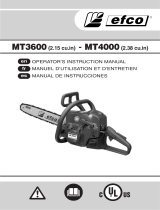
• Never use the product if you are fatigued, while
under the influence of alcohol or drugs, medication
or anything that could affect your vision, alertness,
coordination or judgment.
• Do not use the product in bad weather such as
dense fog, heavy rain, strong wind, intense cold,
etcetera. Working in bad weather is tiring and often
brings added risks, such as icy ground,
unpredictable felling direction, etcetera.
• Never start a product unless the guide bar, saw
chain and all covers are fitted correctly. Refer to
Assembly on page 13
for instructions. Without a bar
and saw chain attached to the product the clutch can
come loose and cause serious injury.
(Fig. 22)
• Never start the product indoors. Exhaust fumes can
be dangerous if inhaled.
• The exhaust fumes from the engine are hot and can
contain sparks, which can start a fire. Never start the
product near flammable material!
• Observe your surroundings and make sure that there
is no risk of people or animals coming in contact with
or affect your control of the product.
• Never allow children to use or be in the vicinity of the
product. As the product is equipped with a spring-
loaded start/stop switch and can be started by low
speed and force on the starter handle, even small
children under some circumstances can produce the
force necessary to start the product. This can mean
a risk of serious personal injury. Therefore remove
the spark plug cap when the product is not under
close supervision.
• You must have a steady stance in order to have full
control of the product. Never work standing on a
ladder, in a tree or where you do not have a firm
ground to stand on.
(Fig. 23)
• Lack of concentration can lead to kickback if the
kickback zone of the bar accidentally touches a
branch, nearby tree or some other object.
(Fig. 24)
• Never use the product by holding it with one hand.
This product is not safely controlled with one hand.
• Always hold the product with both hands. The right
hand should be on the rear handle, and the left hand
on the front handle. All people, whether right or left
handed, should use this grip. Use a firm grip with
thumbs and fingers encircling the handles. This grip
minimizes the risk of kickback and lets you keep the
product under control. Do not let go of the handles!
(Fig. 25)
• Never use the product above shoulder height.
(Fig. 26)
• Do not use the product in a situation where you
cannot call for help in case of an accident.
• Before moving your product, switch off the engine
and lock the saw chain using the chain brake. Carry
the product with the guide bar and saw chain
pointing backwards. Fit a transportation guard to the
guide bar before transporting the product or carrying
it for any distance.
• When you put the product on the ground, lock the
saw chain using the chain brake and ensure you
have a constant view of the product. Switch the
engine off before leaving your product for any length
of time.
• Sometimes chips get stuck in the clutch cover
causing the saw chain to jam. Always stop the
engine before cleaning.
• Running an engine in a confined or badly ventilated
area can result in death due to carbon monoxide
poisoning.
• Use the chain brake as a parking brake when you
start the product and when you move short
distances. Always carry the product in the front
handle. This decreases the risk that you or a person
near you get hit by the saw chain.
• It is not possible to cover every conceivable situation
you can face when using this product. Always
exercise care and use your common sense. Avoid all
situations which you consider to be beyond your
capability. If you still feel uncertain about operating
procedures after reading these instructions, you
should consult an expert before continuing. Do not
hesitate to contact your dealer or Husqvarna if you
have any questions about the use of the product. We
will willingly be of service and provide you with
advice as well as help you to use your product both
efficiently and safely. Attend a training course in
chainsaw usage if possible. Your dealer, forestry
school or your library can provide information about
which training materials and courses are available.
(Fig. 27)
• When using this product, a fire extinguisher should
be available.
• Keep handles dry, clean and free from oil.
• Beware of carbon monoxide poisoning. Operate the
product in a well ventilated area only.
• Do not attempt a pruning or limbing operation in a
standing tree unless specifically trained to do so.
Personal protective equipment
WARNING:
Read the warning instructions
that follow before you use the product.
(Fig. 28)
• Most chainsaw accidents occur when the saw chain
touches the operator. You must use approved
personal protective equipment during operation.
Personal protective equipment does not give you full
protection from injuries but it decreases the degree
of injury if an accident occurs. Speak to your
servicing dealer for recommendations about which
equipment to use.
1270 - 002 - 30.06.2020
11





















